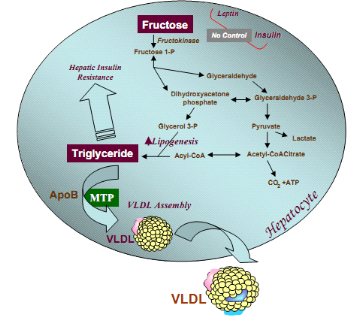I.1.10.2. Diet induction
model
Experimental cardiovascular risk factors of diabetes
complications are usually induced by the consumption of high fat diet, high
sucrose diet, and high cholesterol diet depending on the pathological state
that is to be induced. For instance, it has been shown that rats fed on high
fructose diet mimic the progression of type 2 diabetes seen in humans including
glucose intolerance, increased oxidative stress, hypertension, and reduced
myocardial and vascular compliance (Jatin et al.,
2011).
I.1.11. Metabolism of fructose, glucose and type 2 diabetes
mellitus
Dietary fructose undergoes rapid metabolism by the liver since
most cells lack glut-5 transporter which transport fructose into cells. In
contrast, hepatic glucose metabolism is limited by the capacity to store
glucose as glycogen and, more importantly, by the inhibition of glycolysis and
further glucose uptake resulting from the effects of citrate and ATP to inhibit
phosphofructokinase. Because fructose uptake by the liver is not inhibited at
the level of phosphofructokinase, fructose consumption results in larger
increases of circulating lactate than does consumption of a comparable amount
of glucose (Angela et al., 2007). Low-dose fructose
has also been found to restore the ability of hyperglycaemia to regulate
hepatic glucose production. In addition, fructose ingestion results in smaller
postprandial glycemic excursions compared to glucose and glucose-containing
carbohydrates (starches) that are rapidly absorbed as glucose. However,
increased blood fructose concentrations could also contribute to glycation and
diabetic complications (Angela et al., 2007).
In contrast to low doses of fructose, when much larger amounts
of fructose are consumed (e.g., in sucrose- and HFCS- sweetened beverages),
fructose continues to enter the glycolytic pathway distal to
phosphofructokinase and hepatic triacylglycerol production is facilitated.
Thus, unlike glucose metabolism, in which the uptake of glucose is negatively
regulated at the level of phosphofructokinase, high concentrations of fructose,
can serve as a relatively unregulated source of acetyl-CoA (George
et al., 2007). Thus, fructose is more lipogenic than glucose,
an effect that might be exacerbated in subjects with existing hyperlipidemia or
insulin resistance or type 2 diabetes (Heather et al.,
2005). In contrast to glucose, dietary fructose does not stimulate
insulin or leptin (which are both important regulators of energy intake and
body adiposity). Therefore, the decrease in insulin responses to meals and
leptin production associated with chronic consumption of diets high in fructose
may have deleterious long-term effects on the regulation of energy intake and
body adiposity (Jatin et al., 2011). Another recent
report has proposed a hypothesis relating fructose intake to the long-known
relation between uric acid and heart disease. The ADP formed from ATP after
phosphorylation of fructose on the 1-position can be further metabolized to
uric acid. The metabolism of fructose in the liver drives the production of
uric acid, which utilizes nitric oxide, a key modulator of vascular function
(George et al., 2007).

Figure 8 : Hepatic fructose metabolism:
highly lipogenic pathway (Heather et al., 2005)
Stimulated triglyceride synthesis is likely to lead to hepatic
accumulation of triglyceride, which has been shown to reduce hepatic insulin
sensitivity, hepatic insulin resistance, glucose intolerance as well as
increased formation of VLDL particles due to higher substrate availability,
increased apoB stability, and higher MTP, the critical factor in VLDL assembly
(Kimber et al., 2008).
| 


